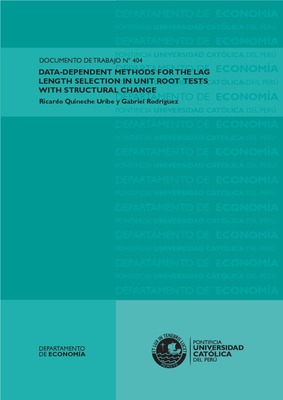| dc.contributor.author | Quineche Uribe, Ricardo | |
| dc.contributor.author | Rodríguez , Gabriel | |
| dc.date.accessioned | 2016-02-17T21:37:53Z | |
| dc.date.available | 2016-02-17T21:37:53Z | |
| dc.date.issued | 2015 | |
| dc.identifier.uri | http://repositorio.pucp.edu.pe/index/handle/123456789/52503 | |
| dc.description.abstract | En este documento se analiza la elección del rezago (truncación) que se utiliza en la aplicación de estadísticos de raíz unitaria tales como el ADFGLS y los tests MGLS propuestos por Elliott et al. (1996) y Ng y Perron (2001) y extendidos al contexto de cambio estructural por Perron y Rodríguez (2003). Dos modelos son considerados: uno que admite un cambio estructural en la pendiente y el otro que admite un cambio estructural en pendiente e intercepto, Se usan simulaciones de Monte Carlo usando varios métodos para seleccionar el largo del rezago: AIC, BIC, MAIC, MBIC. También se incluye y analiza la performance de la propuesta híbrida sugerida por Perron y Qu (2007) la cual usa MCO en lugar de MCG para eliminar los componentes determinísticos cuando se construyen los criterios de información. Todos estos métodos se comparan con el método secuencial t-sig que está basado en la significancia de los rezagos adicionales que se incluyen en la regresión ADF. Los resultados muestran que los estadísticos MGLS presentan valores (negativos) explosivos asociados con elevados valores del rezago seleccionado cuando AIC, AICOLS y t-sig son utilizados. Los valores son tan negativos que implican un sobre rechazo de la hipótesis nula de una raíz unitaria. En el lado opuesto, seleccionar la longitud del rezago usando MAIC, MAICOLS, MBIC, MBICOLS conduce a valores muy pequeños de los estadísticos M lo que implica resultados muy conservadores, es decir, no rechazo de la hipótesis nula. Estos problemas de potencia no son observados en el caso del estadístico ADFGLS por lo cual es muy recomendable. | es_ES |
| dc.description.abstract | We analyze the choice of the truncation lag for unit root tests as the ADFGLS and the MGLS tests proposed by Elliott et al. (1996) and Ng and Perron (2001) and extended to the context of structural change by Perron and Rodríguez (2003). We consider the models that allows for a change in slope and a change in the intercept and slope at unknown break date, respectively. Using Monte-Carlo experiments, the truncation lag selected according to several methods as the AIC, BIC, MAIC, MBIC is analyzed. We also include and analyze the performance of the hybrid version suggested by Perron and Qu (2007) which uses OLS instead of GLS detrended data when constructing the information criteria. All these methods are compared to the sequential t-sig method based on testing for the significance of coefficients on additional lags in the ADF autoregression. Results show that the MGLS tests present explosive values associated with large values of the lag selected which happens more often when AIC, AICOLS and t-sig are used to select the lag length. The values are so negative that imply an over rejection of the null hypothesis of a unit root. On the opposite side, lag length selected using MAIC, MAICOLS, MBIC, MBICOLS methods lead to very small values of the M-tests implying very conservative results, that is, no rejection of the null hypothesis. These opposite power problems are not observed in the case of the ADFGLS test for which it is highly recommended. | en_US |
| dc.language.iso | spa | es_ES |
| dc.publisher | Pontificia Universidad Católica del Perú. Departamento de Economía | es_ES |
| dc.relation.ispartof | urn:issn:2079-8466 | |
| dc.relation.ispartof | urn:issn:2079-8474 | |
| dc.relation.ispartofseries | Documento de Trabajo;404 | es_ES |
| dc.rights | info:eu-repo/semantics/openAccess | es_ES |
| dc.rights.uri | http://creativecommons.org/licenses/by-nc-nd/2.5/pe/ | * |
| dc.subject | Criterios de Información | es_ES |
| dc.subject | Detrending por GLS | es_ES |
| dc.subject | Estadísticos de Raíz Unitaria | es_ES |
| dc.subject | Método Secuencial de lo General a lo Específico t-sig | es_ES |
| dc.subject | Rezago | es_ES |
| dc.title | Métodos dependientes de datos para la selección longitudinal de retrasos en pruebas de raíz unitarias con cambio estructural. | es_ES |
| dc.title.alternative | Data-Dependent Methods for the Lag Length Selection in Unit Root Tests with Structural Change | en_US |
| dc.type | info:eu-repo/semantics/workingPaper | |
| dc.type.other | Documento de trabajo | |
| dc.subject.ocde | http://purl.org/pe-repo/ocde/ford#5.02.00 | |
| dc.publisher.country | PE | |
| renati.advisor.orcid | https://orcid.org/0000-0003-1174-9642 | |


